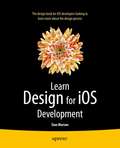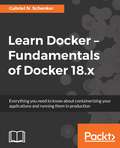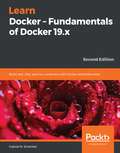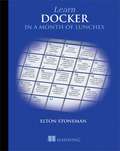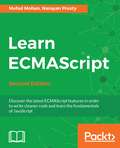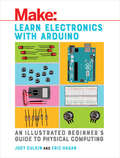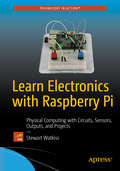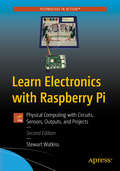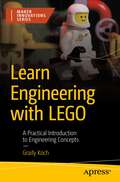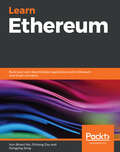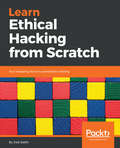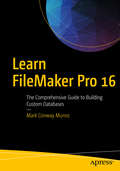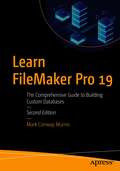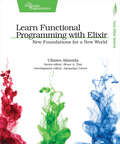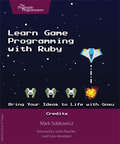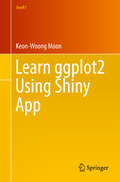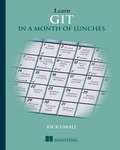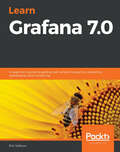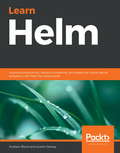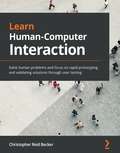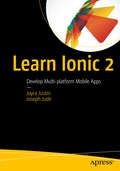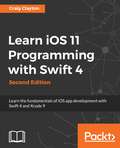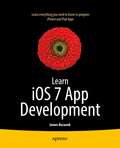- Table View
- List View
Learn Design for iOS Development
by Sian MorsonLearn Design for iOS Development is for you if you're an iOS developer and you want to design your own apps to look great and be in tune with the latest Apple guidelines. You'll learn how to design your apps to work with the exciting new iOS 7 look and feel, which your users expect within their latest apps. Learn Design for iOS Development guides you through the design processes that you can apply to design your own apps brilliantly. We'll start at the idea stages of your apps, and you'll see how you can analyze and apply the right design patterns for every app you are coding, use wireframing tools to take your ideas forward, and use Photoshop to create the visual assets you want to look great in your app. You'll understand why Apple have made the decisions they've made with the new iOS 7 interface and new HIG guidelines, and from that insight you'll be able to vision and create your own apps, on iPhones and iPads, that work perfectly within the new iOS 7 interface. What you'll learn How to build apps that work within the exciting new iOS 7 design paradigm How to design great looking apps that your users will find a pleasure to use The deeper design elements you can apply to your apps What is and how to use Apple's Human Interface Guidelines (HIG) How to go beyond Apple's HIG guidelines to create innovative apps Design pattern basics and how you can use them How to use wireframes to create your app How to use Adobe Photoshop to create the visual assets for your apps How to create your app's icon and additional graphics for the App Store Extra considerations for iPad app design considerations Common design best practices and mistakes Who this book is for This book is for iOS developers who know that they can code well, but want to know how they can build apps to also have brilliant designs. This book is also a guide for all iOS app developers who want their apps to look contemporary within the new iOS 7 interface guidelines. Table of Contents 1. You've Got an Idea for an iPhone App, Now What? 2. iOS: What You Need to Know 3. iOS 7 and Flat Design 4. Getting to Know the User Interface of the iPhone and iPad Design Considerations 5. Mobile Design Patterns 6. Using Wireframes to Design Your App 7. Designing Your Visual Assets with Adobe Photoshop 8. Creating Your App Icon and Additional Graphics for the App Store 9. Finalizing Your Assets for App Development 10. Design Best Practices and Mistakes to Avoid
Learn Docker - Fundamentals of Docker 18.x: Everything you need to know about containerizing your applications and running them in production
by Gabriel Nicolas SchenkerEnhance your software deployment workflow using containersKey Features●Get up-and-running with basic to advanced concepts of Docker●Get acquainted with concepts such as Docker containers, Docker images, orchestrators and so on.●Practical test-based approach to learning a prominent containerization toolBook DescriptionDocker containers have revolutionized the software supply chain in small and big enterprises. Never before has a new technology so rapidly penetrated the top 500 enterprises worldwide. Companies that embrace containers and containerize their traditional mission-critical applications have reported savings of at least 50% in total maintenance cost and a reduction of 90% (or more) of the time required to deploy new versions of those applications. Furthermore they are benefitting from increased security just by using containers as opposed to running applications outside containers.This book starts from scratch, introducing you to Docker fundamentals and setting up an environment to work with it. Then we delve into concepts such as Docker containers, Docker images, Docker Compose, and so on. We will also cover the concepts of deployment, orchestration, networking, and security. Furthermore, we explain Docker functionalities on public clouds such as AWS.By the end of this book, you will have hands-on experience working with Docker containers and orchestrators such as SwarmKit and Kubernetes.What you will learn●Containerize your traditional or microservice-based application●Share or ship your application as an immutable container image●Build a Docker swarm and a Kubernetes cluster in the cloud●Run a highly distributed application using Docker Swarm or Kubernetes●Update or rollback a distributed application with zero downtime●Secure your applications via encapsulation, networks, and secrets●Know your options when deploying your containerized app into the cloudWho this book is forThis book is targeted at system administrators, operations engineers, DevOps engineers, and developers or stakeholders who are interested in getting started with Docker from scratch. No prior experience with Docker Containers is required.
Learn Docker - Fundamentals of Docker 19.x: Build, test, ship, and run containers with Docker and Kubernetes, 2nd Edition
by Gabriel N. SchenkerExplore the core functionality of containerizing your applications and making them production-ready Key Features Grasp basic to advanced Docker concepts with this comprehensive guide Get acquainted with Docker containers, Docker images, orchestrators, cloud integration, and networking Learn to simplify dependencies and deploy and test containers in production Book Description Containers enable you to package an application with all the components it needs, such as libraries and other dependencies, and ship it as one package. Docker containers have revolutionized the software supply chain in both small and large enterprises. Starting with an introduction to Docker fundamentals and setting up an environment to work with it, you'll delve into concepts such as Docker containers, Docker images, and Docker Compose. As you progress, the book will help you explore deployment, orchestration, networking, and security. Finally, you'll get to grips with Docker functionalities on public clouds such as Amazon Web Services (AWS), Azure, and Google Cloud Platform (GCP), and learn about Docker Enterprise Edition features. Additionally, you'll also discover the benefits of increased security with the use of containers. By the end of this Docker book, you'll be able to build, ship, and run a containerized, highly distributed application on Docker Swarm or Kubernetes, running on-premises or in the cloud. What you will learn Containerize your traditional or microservice-based applications Develop, modify, debug, and test an application running inside a container Share or ship your application as an immutable container image Build a Docker Swarm and a Kubernetes cluster in the cloud Run a highly distributed application using Docker Swarm or Kubernetes Update or rollback a distributed application with zero downtime Secure your applications with encapsulation, networks, and secrets Troubleshoot a containerized, highly distributed application in the cloud Who this book is for This book is for system administrators, operations engineers, DevOps engineers, and developers or stakeholders who are interested in getting started with Docker from scratch. No prior experience with Docker containers is required.
Learn Docker in a Month of Lunches
by Elton StonemanSummary Go from zero to production readiness with Docker in 22 bite-sized lessons! Learn Docker in a Month of Lunches is an accessible task-focused guide to Docker on Linux, Windows, or Mac systems. In it, you&’ll learn practical Docker skills to help you tackle the challenges of modern IT, from cloud migration and microservices to handling legacy systems. There&’s no excessive theory or niche-use cases—just a quick-and-easy guide to the essentials of Docker you&’ll use every day. Purchase of the print book includes a free eBook in PDF, Kindle, and ePub formats from Manning Publications. About the technology The idea behind Docker is simple: package applications in lightweight virtual containers that can be easily installed. The results of this simple idea are huge! Docker makes it possible to manage applications without creating custom infrastructures. Free, open source, and battle-tested, Docker has quickly become must-know technology for developers and administrators. About the book Learn Docker in a Month of Lunches introduces Docker concepts through a series of brief hands-on lessons. Following a learning path perfected by author Elton Stoneman, you&’ll run containers by chapter 2 and package applications by chapter 3. Each lesson teaches a practical skill you can practice on Windows, macOS, and Linux systems. By the end of the month you&’ll know how to containerize and run any kind of application with Docker. What's inside Package applications to run in containers Put containers into production Build optimized Docker images Run containerized apps at scale About the reader For IT professionals. No previous Docker experience required. About the author Elton Stoneman is a consultant, a former architect at Docker, a Microsoft MVP, and a Pluralsight author. Table of Contents PART 1 - UNDERSTANDING DOCKER CONTAINERS AND IMAGES 1. Before you begin 2. Understanding Docker and running Hello World 3. Building your own Docker images 4. Packaging applications from source code into Docker Images 5. Sharing images with Docker Hub and other registries 6. Using Docker volumes for persistent storage PART 2 - RUNNING DISTRIBUTED APPLICATIONS IN CONTAINERS 7. Running multi-container apps with Docker Compose 8. Supporting reliability with health checks and dependency checks 9. Adding observability with containerized monitoring 10. Running multiple environments with Docker Compose 11. Building and testing applications with Docker and Docker Compose PART 3 - RUNNING AT SCALE WITH A CONTAINER ORCHESTRATOR 12. Understanding orchestration: Docker Swarm and Kubernetes 13. Deploying distributed applications as stacks in Docker Swarm 14. Automating releases with upgrades and rollbacks 15. Configuring Docker for secure remote access and CI/CD 16. Building Docker images that run anywhere: Linux, Windows, Intel, and Arm PART 4 - GETTING YOUR CONTAINERS READY FOR PRODUCTION 17. Optimizing your Docker images for size, speed, and security 18. Application configuration management in containers 19. Writing and managing application logs with Docker 20. Controlling HTTP traffic to containers with a reverse proxy 21. Asynchronous communication with a message queue 22. Never the end
Learn ECMAScript - Second Edition: Discover the latest ECMAScript features in order to write cleaner code and learn the fundamentals of JavaScript, 2nd Edition
by Mehul MohanGet up and running with all the new features of ECMAScript and explore new ways of coding with JavaScript. Key Features Grasp the latest features of ECMAScript and the best way to use it in production code Learn newly added native APIs to JS Engine and perform tasks efficiently with a cleaner code base Understand the more complex sides of JavaScript such as the inheritance model, low-level memory management, multithreaded environments, and web workers Book Description Learn ECMAScript explores implementation of the latest ECMAScript features to add to your developer toolbox, helping you to progress to an advanced level. Learn to add 1 to a variable andsafely access shared memory data within multiple threads to avoid race conditions. You’ll start the book by building on your existing knowledge of JavaScript, covering performing arithmetic operations, using arrow functions and dealing with closures. Next, you will grasp the most commonly used ECMAScript skills such as reflection, proxies, and classes. Furthermore, you’ll learn modularizing the JS code base, implementing JS on the web and how the modern HTML5 + JS APIs provide power to developers on the web. Finally, you will learn the deeper parts of the language, which include making JavaScript multithreaded with dedicated and shared web workers, memory management, shared memory, and atomics. It doesn’t end here; this book is 100% compatible with ES.Next. By the end of this book, you'll have fully mastered all the features of ECMAScript! What you will learn Implement methods associated with objects as per the latest ECMAScript specification Make use of the latest features of ECMAScript Make use of many new APIs in HTML5 and modern JavaScript implementation Use SharedArrayBuffers for superfast concurrent and parallel programming Perform asynchronous programming with JavaScript Implement the best ways and practices to perform modular programming in JavaScript Who this book is for This book is for web developers who have some basic programming knowledge and want to learn to write cleaner code with the power of ECMAScript.
Learn Electronics with Arduino: An Illustrated Beginner's Guide to Physical Computing
by Jody Culkin Eric HaganThis book is your introduction to to physical computing with the Arduino microcontroller platform. No prior experience is required, not even an understanding of basic electronics. With color illustrations, easy-to-follow explanations, and step-by-step instructions, the book takes the beginner from building simple circuits on a breadboard to setting up the Arduino IDE and downloading and writing sketches to run on the Arduino. Readers will be introduced to basic electronics theory and programming concepts, as well as to digital and analog inputs and outputs. Throughout the book, debugging practices are highlighted, so novices will know what to do if their circuits or their code doesn't work for the current project and those that they embark on later for themselves. After completing the projects in this book, readers will have a firm basis for building their own projects with the Arduino.Written for absolute beginners with no prior knowledge of electronics or programmingFilled with detailed full-color illustrations that make concepts and procedures easy to followAn accessible introduction to microcontrollers and physical computingStep-by-step instructions for projects that teach fundamental skillsIncludes a variety of Arduino-based projects using digital and analog input and output
Learn Electronics with Raspberry Pi
by Stewart WatkissLearning electronics can be tremendous fun -- your first flashing LED circuit is a reason to celebrate! But where do you go from there, and how can you move into more challenging projects without spending a lot of money on proprietary kits? One excellent answer is Raspberry Pi. Raspberry Pi is everywhere, it's inexpensive, and it's a wonderful tool for teaching about electronics and programming. Learn Electronics with Raspberry Pi shows you how to make a variety of cool projects using the Pi with programming languages like Scratch and Python, with no experience necessary. You'll learn how the Pi works, how to work with Raspbian Linux on the Pi, and how to design and create electronic circuits. You'll then create projects like an arcade game, disco lights, and infrared transmitter, and an LCD display. You'll also learn how to control Minecraft's Steve with a joystick and how to build a Minecraft house with a Pi, and even how to control a LEGO train with a Pi. You'll even learn how to create your own robot, including how to solder and even design a printed circuit board! Author Stewart Watkiss brings a ton of experience and a sense of fun to this delicious array of Pi projects. He's the founder of Penguin Tutor, an enthusiastic STEM ambassador, and the technical reviewer of Mastering the Raspberry Pi and Learn Raspberry Pi with Linux. What you'll learn Learn how to design and build electronic circuits, and even how to make a PCB Learn how to make fun projects like an arcade game, a robot, and a Minecraft controller while learning about sensors and how devices talk to each other Get started programming the Pi with Scratch and Python Who this book is for Makers, students, and teachers who want to learn about electronics and programming with the fun and low-cost Raspberry Pi.
Learn Electronics with Raspberry Pi: Physical Computing with Circuits, Sensors, Outputs, and Projects
by Stewart WatkissUpdated for the recent Raspberry Pi boards, including the Raspberry Pi 4, this new edition offers an all new digital logic circuits project, explaining the theory behind how digital electronics work while creating a new project for measuring temperature.Raspberry Pi is everywhere, it’s inexpensive, and it's a wonderful tool for teaching about electronics and programming. This book demonstrates how to make a variety of cool projects using the Pi with programming languages like Scratch and Python, with no experience necessary. You'll see how the Pi works, how to work with Raspbian Linux on the Pi, and how to design and create electronic circuits. You'll create projects like an arcade game, disco lights, and infrared transmitter, and an LCD display. You'll also learn how to control Minecraft's Steve with a joystick and how to build a Minecraft house with a Pi, and even how to control a LEGO train with a Pi. And, you'll build your own robot, including how to solder and even design a printed circuit board.Learning electronics can be tremendous fun — your first flashing LED circuit is a reason to celebrate! But where do you go from there, and how can you move into more challenging projects without spending a lot of money on proprietary kits? Learn Electronics with Raspberry Pi shows you how to, and a lot more. What You'll LearnDesign and build electronic circuitsMake fun projects like an arcade game, a robot, and a Minecraft controllerProgram the Pi with Scratch and PythonWho This Book Is ForMakers, students, and teachers who want to learn about electronics and programming with the fun and low-cost Raspberry Pi.
Learn Engineering with LEGO: A Practical Introduction to Engineering Concepts (Maker Innovations Ser.)
by Grady KochLEGO Mindstorms and SPIKE Prime are great products with vast capabilities, but are often so complex that many people don’t know how to use them. LEGO provides a walk-through of a few projects to build, which are cool, but after building these many people get stuck on “now what?” This book answers that question by showing the underlying principles required to build their own ideas.This book is a hands-on tour of how machines work with LEGO—there’s nothing like building a machine with your own to hands to understand how it works. It includes aspects of software engineering, mechanical engineering, and electrical engineering. As parts and associated engineering concepts are presented, they will be shown in their practical use with graphical step-by-step assembly instructions. The concepts conveyed are mostly learned through building examples, with text explanation to reinforce the ideas being learned. Every engineering concept has a building example to go with it, in a quick build of less than 15 assembly steps. At the end of each chapter there’s a project to tie the concepts of the chapter together of a little more complexity, involving 15 to 30 steps. These assembly steps are drawn with a computer aided design program that looks like the diagrams that LEGO produces for its products, so readers will be familiar with the look of the assembly directions. What You'll LearnLayout a Word Blocks or Python computer program from scratchSee how LEGO building elements are meant to be assembledManipulate the power source of a rotating shaft from an electric motorUse gears to alter the speed and torque of a power trainChange the motion from a rotating shaft to a desired action Basic mechanisms (turntable, differential, cam, ratchet, etc.) to Use sensors (motion, distance, light, color) to make interactive inventionsIntegrate mechanical, software, and electrical subsystems in a projectWho This Book Is ForThe knowledge presumed in this book is basic familiarity in building with LEGO, having past experience with building a set of moderate complexity of more than a 100 pieces. Basic familiarity with operating a personal computer is also assumed, such as to install an app. Likely interested readers are: LEGO fans looking for ways to build new and better inventions, middle-school and high-school age students who have an interest in science, math, and engineering, adults who like to learn how things work and tinker with inventions, and educators who use the SPIKE Prime set and are looking for new ideas for lesson plans.
Learn Ethereum: Build your own decentralized applications with Ethereum and smart contracts
by Xun (Brian) Wu Zhihong Zou Dongying SongExplore the blockchain-based decentralized platform and understand how Ethereum works with Dapps examples Key Features Explore the Ethereum ecosystem and understand the latest research on the platform Build decentralized apps (Dapps) using smart contracts and Ethereum with the help of practical examples Learn to make your decentralized applications fast and highly secure Book Description Ethereum is a blockchain-based, decentralized computing platform that allows running smart contracts. This book provides a basic overview of how Ethereum works, its ecosystem, mining process, and the consensus mechanism. It also demonstrates a step-by-step approach for building decentralized applications. This book begins with the very basics of Blockchain technology. Then it dives deep into the Ethereum architecture, framework and tools in its ecosystem. It also provides you an overview of ongoing research on Ethereum, for example, Layer 1 and 2 scaling solution, Stablecoin, ICO/STO/IEO, etc. Next, it explains Solidity language in detail, and provides step-by-step instructions for designing, developing, testing, deploying, and monitoring decentralized applications. In addition, you'll learn how to use Truffle, Remix, Infura, Metamask, and many other Ethereum technologies. It'll also help you develop your own cryptocurrency by creating ERC20, and ERC721 smart contracts from scratch. Finally, we explain private blockchains, and you learn how to interact with smart contracts through wallets. What you will learn Understand the concepts of blockchain and cryptocurrency Master Ethereum development tools such as Truffle, Remix IDE and Infura Delve into smart contract development Develop DApps frontend using Node.js, React.js, and Web3js API Learn Etherscan and other tools to secure and monitor smart contracts Develop and debug smart contracts by working with Remix Apply Truffle suite to compile, migrate, and unit test smart contracts Explore smart contracts such as ERC20 token and decentralized digital market Who this book is for This book is for all developers and architects who want to explore Ethereum blockchain fundamentals and get started with building real-world decentralized applications. Knowledge of an object-oriented programming language such as JavaScript will be useful but not mandatory.
Learn Ethical Hacking from Scratch: Your stepping stone to penetration testing
by Zaid SabihLearn how to hack systems like black hat hackers and secure them like security expertsKey FeaturesUnderstand how computer systems work and their vulnerabilitiesExploit weaknesses and hack into machines to test their securityLearn how to secure systems from hackersBook DescriptionThis book starts with the basics of ethical hacking, how to practice hacking safely and legally, and how to install and interact with Kali Linux and the Linux terminal. You will explore network hacking, where you will see how to test the security of wired and wireless networks. You’ll also learn how to crack the password for any Wi-Fi network (whether it uses WEP, WPA, or WPA2) and spy on the connected devices.Moving on, you will discover how to gain access to remote computer systems using client-side and server-side attacks. You will also get the hang of post-exploitation techniques, including remotely controlling and interacting with the systems that you compromised. Towards the end of the book, you will be able to pick up web application hacking techniques. You'll see how to discover, exploit, and prevent a number of website vulnerabilities, such as XSS and SQL injections.The attacks covered are practical techniques that work against real systems and are purely for educational purposes. At the end of each section, you will learn how to detect, prevent, and secure systems from these attacks.What you will learnUnderstand ethical hacking and the different fields and types of hackersSet up a penetration testing lab to practice safe and legal hackingExplore Linux basics, commands, and how to interact with the terminalAccess password-protected networks and spy on connected clientsUse server and client-side attacks to hack and control remote computersControl a hacked system remotely and use it to hack other systemsDiscover, exploit, and prevent a number of web application vulnerabilities such as XSS and SQL injectionsWho this book is forLearning Ethical Hacking from Scratch is for anyone interested in learning how to hack and test the security of systems like professional hackers and security experts.
Learn FileMaker Pro 16: The Comprehensive Guide to Building Custom Databases
by Mark Conway MunroExtend FileMaker's built-in functionality and totally customize your data management environment with specialized functions and menus to super-charge the results and create a truly unique and focused experience. This book includes everything a beginner needs to get started building databases with FileMaker and contains advanced tips and techniques that the most seasoned professionals will appreciate. Written by a long time FileMaker developer, this book contains material for developers of every skill level. FileMaker Pro 16 is a powerful database development application used by millions of people in diverse industries to simplify data management tasks, leverage their business information in new ways and automate many mundane tasks. A custom solution built with FileMaker can quickly tap into a powerful set of capabilities and technologies to offer users an intuitive and pleasing environment in which to achieve new levels of efficiency and professionalism. What You’ll learnCreate SQL queries to build fast and efficient formulasDiscover new features of version 16 such as JSON functions, Cards, Layout Object window, SortValues, UniqueValues, using variables in Data Sources Write calculations using built-in and creating your own custom functionsDiscover the importance of a good approach to interface and technical designApply best practices for naming conventions and usage standards Explore advanced topics about designing professional, open-ended solutions and using advanced techniquesWho This Book Is ForCasual programmers, full time consultants and IT professionals.
Learn FileMaker Pro 19: The Comprehensive Guide to Building Custom Databases
by Mark Conway MunroDiscover how easy it is to create multi-user, cross-platform custom solutions with FileMaker Pro, the relational database platform published by Apple subsidiary Claris International, Inc. Meticulously rewritten with clearer lessons, more real-world examples and updated to include feature changes introduced in recent versions, this book makes it easier to get started planning, building and deploying a custom database solution. The material is presented in an easy to follow manner with each chapter building on the last. After an initial review of the user environment and application basics, it begins a deep exploration of the integrated development environment that seamlessly combines the full stack of data table schema, business logic and interface layers into one visual programming experience. This book includes everything needed to get started building custom databases and contains advanced material that seasoned professionals will appreciate. Written by a professional developer with decades of real-world experience, Learn FileMaker Pro 19 is your comprehensive learning and reference guide. Join millions of users and developers worldwide in achieving a new level of workflow efficiency with FileMaker Pro. What You’ll Learn Discover interface and feature changes in FileMaker 17-19Create and maintain healthy filesPlan and create custom tables, fields, relationshipsWrite calculations using built-in and custom functionsBuild recursive and repeating formulasDiscover advanced features using cURL, JSON, SQL, ODBC and FM URLManipulate data files in the computer directory with scriptsDeploy solutions to a server and share with desktop, iOS and web clients Who This Book Is For Casual programmers, full time consultants, and IT professionals
Learn Functional Programming with Elixir: New Foundations For A New World
by Ulisses AlmeidaElixir's straightforward syntax and this guided tour give you a clean, simple path to learn modern functional programming techniques. No previous functional programming experience required! This book walks you through the right concepts at the right pace, as you explore immutable values and explicit data transformation, functions, modules, recursive functions, pattern matching, high-order functions, polymorphism, and failure handling, all while avoiding side effects. Don't board the Elixir train with an imperative mindset! To get the most out of functional languages, you need to think functionally. This book will get you there. Functional programming offers useful techniques for building maintainable and scalable software that solves today's difficult problems. The demand for software written in this way is increasing - you don't want to miss out. In this book, you'll not only learn Elixir and its features, you'll also learn the mindset required to program functionally. Elixir's clean syntax is excellent for exploring the critical skills of using functions and concurrency. Start with the basic techniques of the functional way: working with immutable data, transforming data in discrete steps, and avoiding side effects. Next, take a deep look at values, expressions, functions, and modules. Then extend your programming with pattern matching and flow control with case, if, cond, and functions. Use recursive functions to create iterations. Work with data types such as lists, tuples, and maps. Improve code reusability and readability with Elixir's most common high-order functions. Explore how to use lazy computation with streams, design your data, and take advantage of polymorphism with protocols. Combine functions and handle failures in a maintainable way using Elixir features and libraries. Learn techniques that matter to make code that lives harmoniously with the language. What You Need: You'll need a computer and Elixir 1.4 or newer version installed. No previous functional programming or Elixir experience is required. Some experience with any programming language is recommended.
Learn Game Programming with Ruby: Bring Your Ideas to Life with Gosu
by Mark SobkowiczLevel up your programming skills while making fast-paced, arcade-style video games. Make enemy spaceships explode in balls of fire, and escape from a pit while dodging falling boulders. You'll use the fun and approachable Ruby programming language and the Gosu 2D game library, which makes making games a breeze. Gain the skills and techniques you need to bring your own video game ideas to life with moving images and thumping sounds.If you have a little experience programming in Ruby or another language, then you're ready to start making your own video games. In this book you'll learn concepts such as animation, keyboard and mouse movement, sounds and music, and physics as you build four exciting games.Your first game will test your reflexes as you try to click on a ruby that pops in and out of your screen. Learn how to draw images and text, and how to make objects move around the screen. You'll make a space-shooter where you defend your home base from a seemingly endless stream of enemies, as you discover how to use keyboard input, add music and sounds, an opening title screen, and scrolling end-credits. Next up: make a sliding number puzzle game where you'll learn to incorporate more complicated logic and user interaction into your game. Learn all about game physics as you build a game where a bold adventurer must climb out of a pit while dodging bouncing, spinning rocks. Finally, package up your games as Windows and Mac apps so you can share them with your friends.When you're done with this book, you'll have improved your programming skills, and you'll have all the tools you need to make your own arcade-style games.What You Need:You'll need a computer running Windows 7 or later, or Mac OS X 10.7 or later. All the other software you need is free, and the first chapter will get you up and running.
Learn ggplot2 Using Shiny App
by Keon-Woong MoonThis book and app is for practitioners, professionals, researchers, and students who want to learn how to make a plot within the R environment using ggplot2, step-by-step without coding. In widespread use in the statistical communities, R is a free software language and environment for statistical programming and graphics. Many users find R to have a steep learning curve but to be extremely useful once overcome. ggplot2 is an extremely popular package tailored for producing graphics within R but which requires coding and has a steep learning curve itself, and Shiny is an open source R package that provides a web framework for building web applications using R without requiring HTML, CSS, or JavaScript. This manual--"integrating" R, ggplot2, and Shiny--introduces a new Shiny app, Learn ggplot2, that allows users to make plots easily without coding. With the Learn ggplot2 Shiny app, users can make plots using ggplot2 without having to code each step, reducing typos and error messages and allowing users to become familiar with ggplot2 code. The app makes it easy to apply themes, make multiplots (combining several plots into one plot), and download plots as PNG, PDF, or PowerPoint files with editable vector graphics. Users can also make plots on any computer or smart phone. Learn ggplot2 Using Shiny App allows users to Make publication-ready plots in minutes without coding Download plots with desired width, height, and resolution Plot and download plots in png, pdf, and PowerPoint formats, with or without R code and with editable vector graphics
Learn Git in a Month of Lunches
by Rick UmaliSummaryLearn Git in a Month of Lunches introduces the discipline of source code control using Git. Whether you're a newbie or a busy pro moving your source control to Git, you'll appreciate how this book concentrates on the components of Git you'll use every day. In easy-to-follow lessons designed to take an hour or less, you'll dig into Git's distributed collaboration model, along with core concepts like committing, branching, and merging.Purchase of the print book includes a free eBook in PDF, Kindle, and ePub formats from Manning Publications.About the BookGit is the source code control system preferred by modern development teams. Its decentralized architecture and lightning-fast branching let you concentrate on your code instead of tedious version control tasks. At first, Git may seem like a sprawling beast. Fortunately, to get started you just need to master a few essential techniques. Read on!Learn Git in a Month of Lunches introduces the discipline of source code control using Git. Helpful for both newbies who have never used source control and busy pros, this book concentrates on the components of Git you'll use every day. In easy-to-follow lessons that take an hour or less, you'll dig into Git's distributed collaboration model, along with core concepts like committing, branching, and merging. This book is a road map to the commands and processes you need to be instantly productive.What's InsideStart from square one—no experience requiredThe most frequently used Git commandsMental models that show how Git worksLearn when and how to branch codeAbout the ReaderNo previous experience with Git or other source control systems is required.About the AuthorRick Umali uses Git daily as a developer and is a skilled consultant, trainer, and speaker.Table of ContentsBefore you beginAn overview of Git and version controlGetting oriented with GitMaking and using a Git repositoryUsing Git with a GUITracking and updating files in GitCommitting parts of changesThe time machine that is GitTaking a fork in the roadMerging branchesCloningCollaborating with remotesPushing your changesKeeping in syncSoftware archaeologyUnderstanding git rebaseWorkflows and branching conventionsWorking with GitHubThird-party tools and GitSharpening your Git
Learn Grafana 7.0: A beginner's guide to getting well versed in analytics, interactive dashboards, and monitoring
by Eric SalituroA comprehensive introduction to help you get up and running with creating interactive dashboards to visualize and monitor time-series data in no time Key Features Install, set up, and configure Grafana for real-time data analysis and visualization Visualize and monitor data using data sources such as InfluxDB, Prometheus, and Elasticsearch Explore Grafana's multi-cloud support with Microsoft Azure, Amazon CloudWatch, and Google Stackdriver Book Description Grafana is an open-source analytical platform used to analyze and monitoring time-series data. This beginner's guide will help you get to grips with Grafana's new features for querying, visualizing, and exploring metrics and logs no matter where they are stored. The book begins by showing you how to install and set up the Grafana server. You'll explore the working mechanism of various components of the Grafana interface along with its security features, and learn how to visualize and monitor data using, InfluxDB, Prometheus, Logstash, and Elasticsearch. This Grafana book covers the advanced features of the Graph panel and shows you how Stat, Table, Bar Gauge, and Text are used. You'll build dynamic dashboards to perform end-to-end analytics and label and organize dashboards into folders to make them easier to find. As you progress, the book delves into the administrative aspects of Grafana by creating alerts, setting permissions for teams, and implementing user authentication. Along with exploring Grafana's multi-cloud monitoring support, you'll also learn about Grafana Loki, which is a backend logger for users running Prometheus and Kubernetes. By the end of this book, you'll have gained all the knowledge you need to start building interactive dashboards. What you will learn Find out how to visualize data using Grafana Understand how to work with the major components of the Graph panel Explore mixed data sources, query inspector, and time interval settings Discover advanced dashboard features such as annotations, templating with variables, dashboard linking, and dashboard sharing techniques Connect user authentication to Google, GitHub, and a variety of external services Find out how Grafana can provide monitoring support for cloud service infrastructures Who this book is for This book is for business intelligence developers, business analysts, data analysts, and anyone interested in performing time-series data analysis and monitoring using Grafana. Those looking to create and share interactive dashboards or looking to get up to speed with the latest features of Grafana will also find this book useful. Although no prior knowledge of Grafana is required, basic knowledge of data visualization and some experience in Python programming will help you understand the concepts covered in the book.
Learn Helm: Improve productivity, reduce complexity, and speed up cloud-native adoption with Helm for Kubernetes
by Andrew Block Austin DeweyA comprehensive introduction to automated application deployment on Kubernetes for beginners Key Features Effectively manage applications deployed in Kubernetes using Helm Learn to install, upgrade, share, and manage applications deployed in Kubernetes Get up and running with a package manager for Kubernetes Book Description Containerization is currently known to be one of the best ways to implement DevOps. While Docker introduced containers and changed the DevOps era, Google developed an extensive container orchestration system, Kubernetes, which is now considered the frontrunner in container orchestration. With the help of this book, you'll explore the efficiency of managing applications running on Kubernetes using Helm. Starting with a short introduction to Helm and how it can benefit the entire container environment, you'll then delve into the architectural aspects, in addition to learning about Helm charts and its use cases. You'll understand how to write Helm charts in order to automate application deployment on Kubernetes. Focused on providing enterprise-ready patterns relating to Helm and automation, the book covers best practices for application development, delivery, and lifecycle management with Helm. By the end of this Kubernetes book, you will have learned how to leverage Helm to develop an enterprise pattern for application delivery. What you will learn Develop an enterprise automation strategy on Kubernetes using Helm Create easily consumable and configurable Helm charts Use Helm in orchestration tooling and Kubernetes operators Explore best practices for application delivery and life cycle management Leverage Helm in a secure and stable manner that is fit for your enterprise Discover the ins and outs of automation with Helm Who this book is for This book is for Kubernetes developers or administrators who are interested in learning Helm to provide automation for application development on Kubernetes. Although no prior knowledge of Helm is required, basic knowledge of Kubernetes application development will be useful.
Learn Human-Computer Interaction: Solve human problems and focus on rapid prototyping and validating solutions through user testing
by Christopher Reid BeckerExplore fundamentals, strategies, and emerging techniques in the field of human-computer interaction to enhance how users and computers interact Key Features Explore various HCI techniques and methodologies to enhance the user experience Delve into user behavior analytics to solve common and not-so-common challenges faced while designing user interfaces Learn essential principles, techniques and explore the future of HCI Book Description Human-Computer Interaction (HCI) is a field of study that researches, designs, and develops software solutions that solve human problems. This book will help you understand various aspects of the software development phase, from planning and data gathering through to the design and development of software solutions. The book guides you through implementing methodologies that will help you build robust software. You will perform data gathering, evaluate user data, and execute data analysis and interpretation techniques. You'll also understand why human-centered methodologies are successful in software development, and learn how to build effective software solutions through practical research processes. The book will even show you how to translate your human understanding into software solutions through validation methods and rapid prototyping leading to usability testing. Later, you will understand how to use effective storytelling to convey the key aspects of your software to users. Throughout the book, you will learn the key concepts with the help of historical figures, best practices, and references to common challenges faced in the software industry. By the end of this book, you will be well-versed with HCI strategies and methodologies to design effective user interfaces. What you will learn Become well-versed with HCI and UX concepts Evaluate prototypes to understand data gathering, analysis, and interpretation techniques Execute qualitative and quantitative methods for establishing humans as a feedback loop in the software design process Create human-centered solutions and validate these solutions with the help of quantitative testing methods Move ideas from the research and definition phase into the software solution phase Improve your systems by becoming well-versed with the essential design concepts for creating user interfaces Who this book is for This book is for software engineers, UX designers, entrepreneurs, or anyone who is just getting started with user interface design and looking to gain a solid understanding of human-computer interaction and UX design. No prior HCI knowledge is required to get started.
Learn Internet & E-mail in 24 Hours
by Anitha Vasanth BennettThe Internet boom today has led to a tremendous mind-boggling increase in the number of net users. An average layman, who has not yet come to terms with this technology change, struggles to find an identity for himself. He has very insufficient or in the most cases no knowledge at all about this new world. Lots of books and brochures etc have been published to define this change in technology but the information is too scattered, insufficient or too high-strung. Compiled, as a single handbook for easy reading is "Internet and e-mail in 24 hours". It will prove to be "The Answer" for all the queries for which you have always searched for solutions...Surf through - The world is yours to browse.
Learn Ionic 2
by Joyce Justin Joseph JudeExplore key scenarios required for building quality Ionic apps quickly and easily and bring them to the iOS and Android mobile ecosystem. Learn Ionic 2 explains various techniques to quickly integrate third-party back end systems. With this short guide, you'll benefit from practical examples of implementing authentication and authorization, connecting to social media, integrating with payment gateway, and analytics integration. This book presents solutions to the challenges faced during the development process of these tasks.Validation is essential to the survival and eventual success of any startup. You validate your business idea by placing a product in the hands of your customers and getting them to interact with it. The Ionic framework makes this possible.What You'll Learn: Master end-to-end hybrid application developmentCreate user management modules including signup, login, and forgotten passwordsUse analytics to evaluate an application using Ionic FrameworkWho This Book Is For: Tech entrepreneurs and businessmen with ideas
Learn iOS 11 Programming with Swift 4: Learn the fundamentals of iOS app development with Swift 4 and Xcode 9
by Craig ClaytonBegin your iOS development journey using Swift 4 and XCode 9 with this easy to learn, practical guide. Key Features Explore the latest features of iOS 11 and Swift 4 to build robust applications Kickstart your iOS development career by building your first application from scratch Manage databases and integrate standard elements such as photos and GPS into your app Book Description You want to build iOS applications but where do you start? Forget sifting through tutorials and blog posts, this book is a direct route into iOS development, taking you through the basics and showing you how to put the principles into practice. So take advantage of this developer-friendly guide and start building applications that may just take the App Store by storm! Whether you're an experienced programmer or a complete novice, this book guides you through every facet of iOS development. From Xcode and Swift, the building blocks of modern iOS development, you'll quickly gain a solid foundation to begin venturing deeper into your development journey. Experienced programmers can jump right in and learn the latest iOS 11 features. You'll also learn advanced topics of iOS design, such as gestures and animations, to give your app the edge. Explore the latest developments in Swift 4 and iOS 11 by incorporating new features, custom-rich notifications, drag and drop features, and the latest developments in SiriKit. With further guidance on beta testing with TestFlight, you'll quickly learn everything you need to get your project on the App Store! What you will learn Get to grips with Swift 4 and Xcode 9, the building blocks of Apple development Get to know the fundamentals of Swift 4, including strings, variables, constants, and control flow Discover the distinctive design principles that define the iOS user experience Build a responsive UI and add privacy to your custom-rich notifications Preserve data and manipulate images with filters and effects Bring in SiriKit to create payment requests inside your app Collect valuable feedback with TestFlight before you release your apps on the App Store Who this book is for This book is for beginners who want to be able to create iOS applications. You do not need any knowledge of Swift or any prior programming experience. However, if you have some programming experience, this book is a great way to get a full understanding of how to create an iOS application from scratch and submit it to the App Store
Learn iOS 11 Programming with Swift 4 Second Edition: Learn The Fundamentals Of Ios App Development With Swift 4 And Xcode 9
by Craig Clayton<P><P>Begin your iOS development journey using Swift 4 and XCode 9 with this easy to learn, practical guide. <P><P>Key Features <P><P>Explore the latest features of iOS 11 and Swift 4 to build robust applications <P><P>Kickstart your iOS development career by building your first application from scratch <P><P>Manage databases and integrate standard elements such as photos and GPS into your app <P><P>Book Description <P><P>You want to build iOS applications but where do you start? Forget sifting through tutorials and blog posts, this book is a direct route into iOS development, taking you through the basics and showing you how to put the principles into practice. So take advantage of this developer-friendly guide and start building applications that may just take the App Store by storm! <P><P>Whether you're an experienced programmer or a complete novice, this book guides you through every facet of iOS development. From Xcode and Swift, the building blocks of modern iOS development, you'll quickly gain a solid foundation to begin venturing deeper into your development journey. Experienced programmers can jump right in and learn the latest iOS 11 features. <P><P>You'll also learn advanced topics of iOS design, such as gestures and animations, to give your app the edge. Explore the latest developments in Swift 4 and iOS 11 by incorporating new features, custom-rich notifications, drag and drop features, and the latest developments in SiriKit. With further guidance on beta testing with TestFlight, you'll quickly learn everything you need to get your project on the App Store! <P><P>What you will learn <P><P>Get to grips with Swift 4 and Xcode 9, the building blocks of Apple development <P><P>Get to know the fundamentals of Swift 4, including strings, variables, constants, and control flow <P><P>Discover the distinctive design principles that define the iOS user experience <P><P>Build a responsive UI and add privacy to your custom-rich notifications <P><P>Preserve data and manipulate images with filters and effects <P><P>Bring in SiriKit to create payment requests inside your app <P><P>Collect valuable feedback with TestFlight before you release your apps on the App Store <P><P>Who This Book Is For <P><P>This book is for beginners who want to be able to create iOS applications. You do not need any knowledge of Swift or any prior programming experience. However, if you have some programming experience, this book is a great way to get a full understanding of how to create an iOS application from scratch and submit it to the App Store
Learn iOS 8 App Development
by James BucanekLearn iOS 8 App Development is both a rapid tutorial and a useful reference. You'll quickly get up to speed with Swift, Cocoa Touch, and the iOS 8 SDK. It's an all-in-one getting started guide to building useful apps. You'll learn best practices that ensure your code will be efficient and perform well, earning positive reviews on the iTunes App Store, and driving better search results and more revenue. The iOS 8 SDK offers powerful new features, and this book is the fastest path to mastering them--and the rest of the iOS SDK --for programmers with some experience who are new to iPhone and iPad app development. Many books introduce the iOS SDK, but few explain how to develop apps optimally and soundly. This book teaches both core Swift language concepts and how to exploit design patterns and logic with the iOS SDK, based on Swift and the Cocoa Touch framework. Why spend months or years discovering the best ways to design and code iPhone and iPad apps when this book will show you how to do things the right way from the start? Get an accelerated treatment of the core fundamentals of Swift. Develop your first app using Xcode's advanced interface design tools. Build your first iPhone app using the code that you're given as you walk through this book. Finally, debug and distribute your first app on Apple's iTunes App Store. Learn how to create apps for any model of iPhone, the iPod Touch, the iPad, or build universal apps that run on all of them. After reading this book, you'll be creating professional quality apps, ready to upload to the app store, making you the prestige and the money you seek
